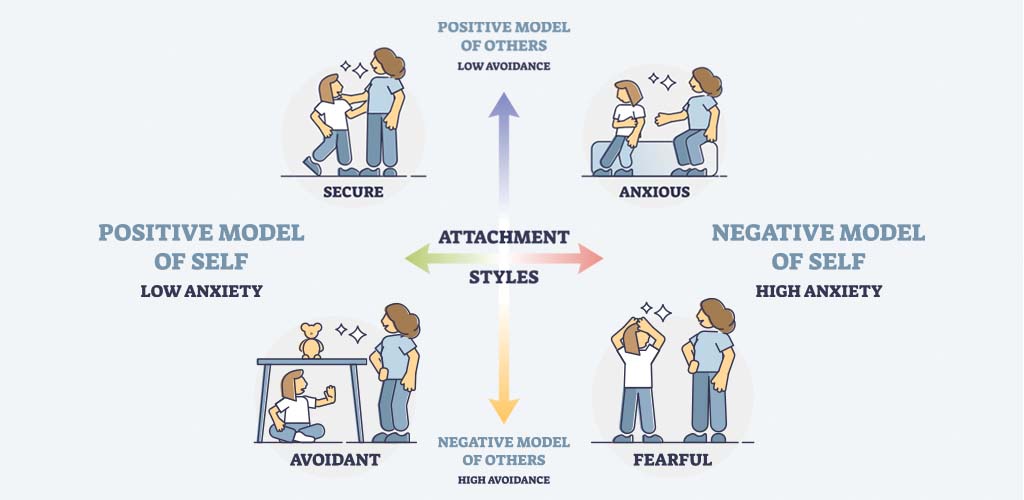Introduction
Humans are born with a need to form a close emotional bond with each other.
As a parent, you might have always wondered how your child’s attachment towards you or any primary caregiver would affect them as an individual. Are you worried they would become a mama’s boy or a cold fish? What influence children to turn out the way they do? What factors affect their ability to form meaningful and satisfying relationships with those around them?
Attachment is often underrated in the role it plays in shaping your personality throughout childhood and beyond. Parents must find the best way to draw positive attachments in children. This process will mould and shape them into healthy children and adults.
With information about different attachment styles in children and how secure attachments can bring out the best in them. This article will review and answer your queries about Bowlby’s attachment theory.
What is Attachment Theory?
Psychologists John Bowlby and Mary Ainsworth developed the attachment theory, which explains emotional bonds in social relationships, human development, and evolutionary influences.
Bowlby hypothesized that the extreme behaviours children engage in to avoid separation from a parent /caregiver or reconnecting with a physically separated parent. Extreme behaviours like crying, screaming, and clinging were evolutionary mechanisms. Bowlby thought these behaviours had possibly been reinforced through natural selection.
These attachment behaviours are spontaneous responses to the perceived threat of losing the survival advantages of being cared for and attended to by the parents or primary caregiver(s).
These behaviours make up what Bowlby termed an “attachment behavioural system,” which guides us in forming and maintaining relationships.
Types of Child Attachment Theory

The following are the four types through which you can determine your child’s attachment style.
- Ambivalent (anxious) attachment: Ambivalent attachment style is considered very rare, affecting an estimated 7% to 15% of children. As a result of poor parental availability, these children cannot depend on or build trust in their parents. Even the temporary absence of primary caregivers can cause distress to the child.
- Avoidant attachment: Children with an avoidant attachment style tend to avoid parents or primary caregivers. They show no preference between a caregiver and a stranger. This attachment might be a result of abusive or neglectful parenting.
- Disorganized attachment: This style can result from parents’ failure to respond to the child’s distress. It is linked to inconsistent caregiver behavior. A child with this attachment style may avoid or resist the parent. In such cases, parents may serve as a source of comfort and fear, leading to disorganized behavior.
- Secure attachment: This is the most common attachment style. Children with secure attachments are happy and trust their primary caregiver(s). They show distress and are visibly upset when separated and joyful when reunited with their parents. Parents who consistently respond to their child’s needs will create securely attached children. When frightened but securely attached, a child is comfortable seeking reassurance from the caregiver(s).
Attachment theory is an innovative observation that explains the importance of the child-parent bond and its long-term effect. In this blog, we’ll look at the origins of this theory and the four attachment types.
According to Child Attachment Theory, early emotional bonds are crucial in creating different kinds of attachment between a child and the parents. The resulting emotional attachment becomes the child’s internal working model, influencing their emotions and intimate relationships .
These internal models are based on the child’s expectations from responsive caretaker(s). These expectations develop an attachment to the caregiver, intimate relationship experiences, and thought processes.
Conclusion
We hope this blog helped you to identify your child’s attachment style. It’s important that parents must be attuned and responsive to their child’s needs and are able to provide appropriate care. A child needs to experience a responsive, affectionate, warm, intimate, and tender relationship with parents to grow up mentally and relationally healthy. This child forms a secure base from which they can explore the environment.
The responsiveness of parents or caregiver(s) helps the child’s holistic development. As a result, this child will handle emotional stress, such as separation anxiety, hostility, and avoidance, with less fear in later relationships.
Also Read…
6 Secret and Successful Co-Parenting Tips



Speak Your Mind
Save my name, email and website in this browser for next time I comment